Posted: 5/27/15
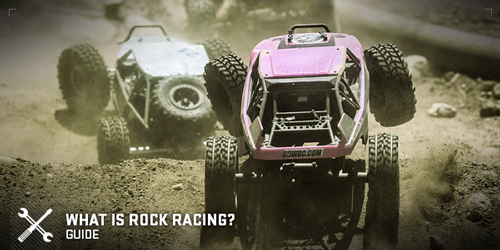
Axial offers vehicles identified as rock crawlers and as rock racers such as the SCX10 and the Yeti, respectively. To make the perfect selection when purchasing your R/C vehicle, you need to know the difference between rock crawling and rock racing.
Rock crawling has been around as long as there have been off-road vehicles like the classic Jeep and rocks to drive them on. The Rubicon Trail in northern California might have originally been used by settlers in covered wagons, but the rocks on that trail have probably seen more rubber tires than wagon wheels. When people think of rock crawling, they often think of this iconic trail or a similar scene and driving over rock formations with beautiful vistas. They see rock crawling as slow, enjoyable and relaxing. They also recognize that it’s challenging. This is recreational rock crawling. It can be a pretty tame trip down an easy trail with a few rocks to negotiate or a hardcore excursion with ample body damage and winching. Recreational rock crawling led to the creation of competitive rock crawling. You probably already know that if it is automotive in nature, it can and will be made into a competition.
Rock crawling, as the name implies, generally takes place on rocky terrain and is not about going fast, but sometimes the skinny pedal is the only way to get up and over something. Not all rock crawling is competitive, of course, but when it is a competition, time is a factor and, thus, speed is a factor. Hence, you'll see plenty of throttle used at rock crawling competitions. The course is most often marked with such items such as cones, tape or rope. Hitting markers results in penalties. So, competitive crawling requires a mix of speed and finesse. You won’t win if you finish with the fastest time, but hit every marker on the course and racked up the time penalties. Conversely, you won’t win a rock crawling competition if you miss every marker with a perfectly executed and clean run, but take all day to finish the course. As described previously, rock crawling is also a popular recreational motorsport. In this case, rock crawling is often called trail riding. Again, as long as the first Jeeps were available to the public, this type of rock crawling has existed.
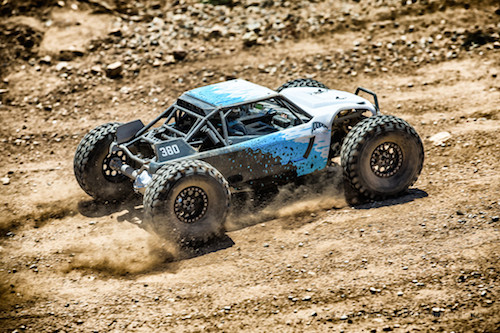
In the same way that just about anything automotive can be made into a competition, any automotive competition can increase in intensity if given a little time. Thus rock crawling has given us rock racing. Rock racing comes in many forms. The first type of rock racing evolved from rock crawling competitions that focused more on speed and less on the finesse needed to avoid markers and the accompanying penalties. Some rock racing competitions feature side-by-side racing by running two vehicles on the course at once. One of the more popular forms of rock racing came from a challenge made between desert racers and rock crawlers. The challenge became an annual event called the King of the Hammers. This race combined high speed desert racing and grueling rock crawling. Both forms of racing have high attrition rates and require specialized equipment.
Besides the increased speeds, one of the biggest differences between rock crawling and rock racing is that most rock racing has the whole field on course at once. Again, some small course rock racing might feature two vehicles that are running partially separated courses, but Ultra4 style racing such as the King of the Hammers has the whole field racing at once. This creates an interesting element as isn't always easy to pass a competitor who's stuck on the rocks you also need to get up and over.
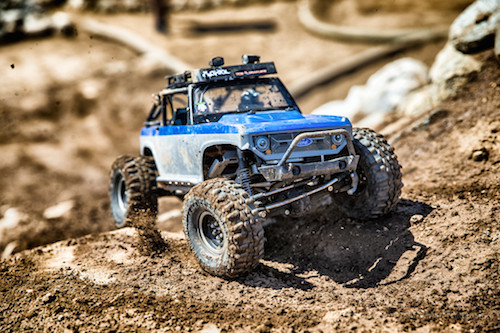
R/C rock racing is mostly patterned after the growing full-size Ultra4 style of racing. While people are R/C rock racing all around the country and world, one organization has stood out as a leading in developing a race format, rules and in promoting events. That racing body is U4RC. Following is an interview that helps explain what rock racing and U4RC are all about.
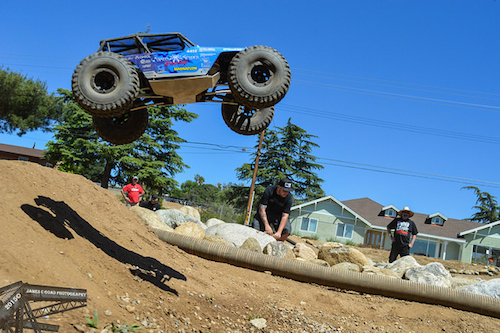
The R/C community is starting to hear more and more about U4RC, but who is behind this still relatively new organization? U4RC is; Jerry Tobin (owner/founder), Brian Jones (owner/co-founder) and Jerry Ellifritz (owner/promoter). Between the three owners of U4RC there is a very solid background in R/C. Jerry Tobin has been in the SoCal R/C crawling scene since 2005. Jerry competed in competitive R/C crawling at a national level for several seasons and was ranked in the top 15 for USRCCA Super class. In 2009, Tobin created the infamous “King of the Compound” R/C endurance rock/desert race which U4RC, as we know it today, was born from. Brian Jones was around when R/C rock crawling was in its infancy and still on the pages of the monster truck forums, which RCCrawler.com stemmed from originally. Brian has been highly involved over the years in many aspects of growth in the crawling segment of R/C, including exhibitions, trade shows and was one of the original owners of RCP Crawlers. Brian too, was a national level ranked competitive crawler. He even attended the first USRCCA Nationals event in Moab, Utah. Jerry Ellifritz has been involved in R/C crawling for about five years, and comes from the scale side of the hobby originally. In those five years, Jerry has immersed himself deeply in R/C crawling including coordinating “G6” scale events, several one-off scale events and, of course, U4RC. Jerry’s involvement with U4 has proven to be invaluable to the advancement of this exciting, new segment of R/C.
Tell us about U4RC? What is its mission? Who is it geared towards? U4RC is an R/C rock racing organization that was launched in 2012. Our mission is to deliver R/C racing with a real, grass roots operating style and feel to it, unlike what is mostly available to the “go fast” R/C community. Currently the majority of the racers are from the R/C crawling world, although we are surprised constantly by the influx of inquiries and new racers from the “go fast” community. We feel U4RC is a great “crossover” of several genres, mainly because “racers” as well as “scalers” can find common ground within the classes available through U4RC. The class structure is set up so that everyone from a “newbie” with a box stock RTR rig, (SCX10, Spawn, Yeti, Wraith) all the way to advanced custom tuber chassis “builders/racers” have a competitive, fun class to run in.
How many tracks are affiliated with U4RC and what are they typically like? The list of tracks is growing quickly throughout the nation and globally, with tracks in SoCal, NorCal, Washington, Arizona, Florida, Minnesota and so forth. There are currently at least a dozen dedicated U4RC tracks at R/C facilities nationally. There are also U4RC tracks and clubs globally, including Canada, Australia, Austria, South America, Italy, Poland and so on (too many places to list).
Given that U4RC is modeled after full-size rock racing, tracks are typically a design that is different from what is considered the “norm” in R/C off-road racing. U4 tracks are not generally groomed (with the exception of watering), there is no sticky stuff, and you will never see a broom used on a U4 track. In contrast, our tracks usually include one or two rock gardens, a hill climb obstacle, elevation changes, jumps, whoops, wide open straights, stutter jumps, semi-tight technical sections, moguls, sand/gravel pits, etc.
What is the U4RC race format? U4RC runs a heads up heat, LCQ (Last Chance Qualifier), Main style racing format, where top finishing positions are key in every “Heat” round for advancement to the “Main” races. We feel this format is the purest way to find the best of the best for the day. Many forms of R/C racing run a “quickest time” advancement structure during lower rounds. Not at U4RC, we want to avoid drivers having an opportunity to sandbag early in the day by just getting a good “hot lap” time in and not conserving the rig because the track itself is a challenge along with the fellow racers you’re up against.
U4RC, like the full-size competition it models, combines go-fast racing and extreme rock crawling. Who usually does better, the racer types or the rock crawlers? That is a difficult question to accurately answer due to the varying terrains on the different U4RC tracks. The racer types definitely excel on the faster, less technical tracks where high speed vehicle control is key. The crawlers that learn to “go fast” well tend to be very successful due to the fact that you have to conserve your rig to a certain extent during the course of a U4 race. Overall the fastest racers to date in U4RC are the rock crawling crowd, which is very similar scenario when compared to our full size counterparts. Once the racer types learn to conserve their rigs, look out!
What classes are there in U4RC? Describe how the Axial Yeti, Wraith and SCX10 typically fit in the various classes? There are six classes in U4RC racing currently. There is a class available for every Axial rig made at this point. The classes are 1.9 Trail, 1.9 Comp, 1.9 Trophy, 2.2 Comp (Limited), 2.2 Comp (Open) and 2.2 Trophy. The SCX10 platform falls into the 1.9 Trail class, which is intended for trail rigs such as (but not limited to) a “G6” or “1.9 Deadbolt” or “Falken” SCX10. For Wraith owners, there is 2.2 Comp (limited), which is limited to a Solid/Solid axle configuration. The Wraith “Spawn” rock racer is a great starting point for this class. All Wraith models are legal for this class in their stock configuration. Axial Yeti owners have a place to race in 2.2 Comp (Open), which is open to the IFS/Solid axle configuration of the Yeti. The Yetis have proven to totally dominate 2.2 Comp Open since its release last year. Not to be forgotten is the fact that the majority of the 1.9 and 2.2 Trophy class rigs are either built using the SCX10 (1.9) and Wraiths (2.2) as their base for the builds.
Is there a class for the Axial Yeti XL? We are currently writing rules for the next series that will include a class for the Axial Yeti XL. The XL hit the market just after the current rules were released last year. Given the success and performance of the RTR version and the recently released kit version, we definitely will provide a place for XL Yeti owners to compete. U4RC track in the future will be designed with consideration of the Yeti XL.
What goes into a good U4RC vehicle? Probably the most important thing would be choosing the right components. U4RC racing is hard on parts so choosing the right upgrades for your application is a must. In an entry-level class where your car is close to stock, the smart thing would be to upgrade the smaller parts before, say, throwing a 3S pack and a 4000+ Kv motor in it. Those things are more suited for the fully built rigs of the mod and trophy classes. Another very important aspect of setting up a car is suspension. Good shocks, springs and the right oil combo makes a huge difference. Since we race at different tracks, with varying technical levels and obstacles, that means the driver needs to be on top of their set-up at all times. Of course, as in all racing, tires are also a big deal. Some drivers actually sipe their own tires for different tracks, just as in the 1:1 world. Fortunately, we have recently had companies designing not only tires, but many other parts specifically for U4RC racing and the results have been outstanding. If you take a look at our sponsor list you will see what I mean.
There's an old saying in racing that to finish first you must first finish. That seems to have been suited for Ultra4 racing. Do you have any driving advice you can share for U4RC racers? You nailed it 100% with that statement. That old adage couldn’t apply any more that to U4RC racing. A conservative driving style will get your rig to the finish line, because you are racing against other drivers as well as the challenging terrain. The racers that have a “wide open” driving style generally run a higher risk of catastrophic equipment failures. This is due to the nature of U4 racing and the built-in obstacles throughout the track. Don’t expect the “turn marshal” to win the race for you. Keeping the rubber side down is the way to go. Walk the track prior to your race and identify any obstacles that you will want to avoid or gather your game plan for tackling those obstacles. Final bit of advice is to drive. Get out, drive your rig and learn how it reacts to your inputs from the transmitter.
What do you see in the future for U4RC? We believe that U4RC will bridge the gap between the R/C rock crawling community and the R/C racer community. With the amount of scale realism required from the rules and the extremely fast paced action on the track, it has aspects that both sides will be drawn to. U4RC is holding our first regional level event here on the West Coast this June that is sure to see attendance of U4 racers from all our neighboring states. There has also been overwhelming support and interest from many of the top manufactures in the R/C world, which leads us to believe our future looks bright.
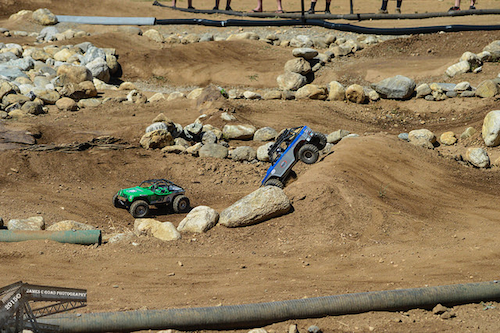
Photos courtesy of U4RC